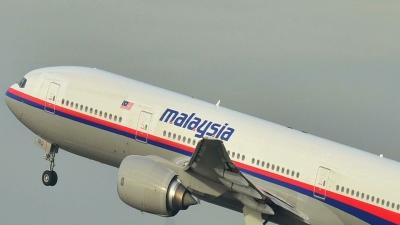Criticised for contradictory statements, slow reactions and a lack of information, the “incompetence” of Malaysian authorities in communicating effectively during a crisis on the scale of its missing jet is painfully evident, analysts say.
Last radio transmission from the cockpit of missing Malaysia Airlines flight 370 was ‘Alright, good night’ as the plane switched from Malaysian to Vietnamese airspace
 Fariq Abdul Hamid invited two women into the cockpit of a of Malaysian airlines flight
Fariq Abdul Hamid invited two women into the cockpit of a of Malaysian airlines flight A CO-PILOT at the controls of the missing Malaysia Airlines flight MH370 invited a Melbourne tourist and her friend into the cockpit where he smoked, took photos and entertained the pair during a previous international flight.
In a worrying lapse of security, it’s been revealed pilot Fariq Abdul Hamid and his colleague broke Malaysia Airline rules when they invited passengers Jonti Roos and Jaan Maree to join them in the cabin for the one-hour flight from Phuket to Kuala Lumpur.
Ms Roos, who is travelling around Australia, told A Current Affair she and Ms Maree posed for pictures with the pilots, who smoked cigarettes during the midair rendezvous.
“Throughout the entire flight they were talking to us and they were actually smoking throughout the flight which I don’t think they’re allowed to do,” Ms Roos said.
 Happy snap … Jonti Roos and Jaan Maree with co-pilot Fariq Abdul Hamid, right, in December 2011. Picture: A Current Affair. Source: Supplied
Happy snap … Jonti Roos and Jaan Maree with co-pilot Fariq Abdul Hamid, right, in December 2011. Picture: A Current Affair. Source: Supplied
“At one stage they were pretty much turned around the whole time in their seats talking to us.
“They were so engaged in conversation that he took my friends hand and he was looking at her palm and said ‘your hand is very creased. That means you’re a very creative person’ and commented on her nail polish.”
Mr Hamid identified the South African nationals as they waited in the boarding queue at Phuket airport in December 2011.
As they took their seats on the aircraft, an air steward approached the women and invited them to join the pilots in the cockpit.
Despite pictures exposing the gross misconduct of the distracted pilots, Ms Roos said she wasn’t concerned for her safety.
“I did feel safe. I don’t think there was one instance where I felt threatened or I felt that they didn’t know what they were doing,” she said.
The whole time I felt they were very friendly. I felt they were very competent in what they were doing.
Not camera shy … Jonti Roos and Jaan Maree in the cockpit of a Malaysia Airlines flight from Phuket to KL in December 2011. Picture: A Current Affair. Source: Supplied
“We wished they (would) stop smoking because it is such a confined space. But you can’t exactly tell a pilot to stop smoking.”
The plucky pilots reportedly wanted Ms Roos and Ms Maree to change their travel arrangements and extend their stay in Kuala Lumpur and join them on a night on the town.
Ms Roos said she was shocked to learn Mr Hamid was at the helm of the ill-fated Malaysia Airlines flight.
“I thought it was crazy. I was just completely shocked. I couldn’t believe it,” she said.
“When I saw all his friends and family posting on his wall my heart really broke for them and my heart broke for the family of the passengers. It’s just a really sad story.”
Malaysia Airlines issued a statement about the incident late last night.
“Malaysia Airlines has become aware of the allegations being made against First Officer, Fariq Ab Hamid which we take very seriously.” the statement said.
“We are shocked by these allegations.
“We have not been able to confirm the validity of the pictures and videos of the alleged incident.
“As you are aware, we are in the midst of a crisis, and we do not want our attention to be diverted.
“We also urge the media and general public to respect the privacy of the families of our colleagues and passengers. It has been a difficult time for them.
“The welfare of both the crew and passenger’s families remain our focus. At the same time, the security and safety of our passengers is of the utmost importance to us.”
Special access … Jaan Maree in the cockpit of a Malaysia Airlines flight in December 2011. Picture: A Current Affair. Source: Supplied
POLICE RELEASE IDENTITY OF ONE STOLEN PASSPORT HOLDER
One of the men travelling with a stolen passport on the Malaysia Airlines flight that mysteriously disappeared has been identified as a 19-year-old Iranian seeking asylum in Europe.
This comes as police downplayed the possibility of terrorist involvement in the disappearance of MH370 — giving four areas of investigation: hijack, sabotage, psychological or personal problems among the passengers and crew.
Malaysian police tonight said the man was Pouria Nour Mohammad Mehrdad, and intelligence suggested he was not likely to be a member of any terrorist group.
Malaysia’s Inspector General of Police, Tan Sri Khalid Abu Bakar, said Mehrdad was travelling on a stolen Austrian passport and was planning to meet up with his mother in Frankfurt.
The second passenger using a stolen passport has not been identified yet.
Revealed … a Malaysian police official displays photographs of the two men who boarded the Malaysia Airlines MH370 flight using stolen European passports to the media. Source: AFP
However, he said police were still considering all possibilities in terms of criminal involvement in the plane’s disappearance, when asked whether police thought the revelation made them consider terrorism less likely in the case.
DID FLIGHT MH370 STALL BEFORE CRASHING?
“At this moment, I would not say less likely. Same weightage to all until we finish our investigations,” Khalid said.
He also contradicted an earlier statement made by Malaysia’s aviation chief that five people did not board the plane, saying they did not exist and everyone who booked a seat was on the flight.
FISHERMAN SAW ‘LOW FLYING LIGHTS’
Authorities are also investigating several reports of locals claiming to have seen the lights of a low-flying aircraft in an area off the Malaysian coast, just below the Malay-Thai border.
It is this area which is now included in the widened search area for missing Malaysia Airlines Flight MH370.
A fisherman who was in his boat at sea, says that at about 1.30am he saw the lights of a low-flying aircraft in the area of Kuala Besar.
Azid Ibrahim told The Star newspaper in Malaysia that the plane was flying so low that the lights were “as big as coconuts”.
And another man, about 30km south of Kota Bharu, is reported to have seen “bright white lights” from what he thought was a fast-descending aircraft at about 1.45am on Saturday morning.
He has since reported what he saw to authorities after seeing the lights from his home that evening.
THE CONSPIRACY THEORIES OF MISSING FLIGHT MH370
DESPERATE SEARCH FOR MALAYSIA AIRLINES FLIGHT MH370
Malaysia Airlines said in a statement that the search and rescue teams (SAR) have expanded the scope beyond the flight path to the West Peninsular of Malaysia at the Straits of Malacca. The authorities are looking at a possibility of an attempt made by MH370 to turn back to Subang.
The search sphere now includes land on the Malaysian peninsula itself, the waters off its west coast and an area to the north of the Indonesian island of Sumatra, an area far removed from flight MH370’s scheduled route.
The news of the search being widened comes as Hong Kong’s Civil Aviation Department said it had received a report from the crew of a Cathay Pacific plane flying from Hong Kong to Kuala Lumpur at about 3pm Saturday that more debris was spotted near Vung Tau, off southeast Vietnam, The South China Morning Post reports.
It is not known if the debris is from the missing Malaysia Airlines aircraft.
Prayer … Students in East China pray for the passengers from the missing Malaysia Airlines plane. Picture: Twitter Source: Supplied
As the search for the missing Boeing 777 continues into its fourth day, it also emerged that the aeroplane underwent maintenance on February 23, 12 days before it went missing bound for Beijing, China.
“The maintenance was conducted at the KLIA hangar and there were no issues on the health of the aircraft,” Malaysia Airlines said. Its next check was due on June 19.
In limbo … Sarah Nor, 55, the mother of 34-year-old Norliakmar Hamid, a passenger on the missing Malaysia Airlines flight MH370. Source: AFP
FINGERPRINTS BEING ANALYSED BY FBI
In other news, fingerprints from the mystery passengers travelling on missing Flight MH370 with stolen passports are being analysed by the FBI as it emerged they were reportedly Iranians looking for a new life in Europe.
The men are believed to have bought the fake travel documents because they were “looking for a place to settle” and it is thought their plane tickets were purchased in Thailand by an Iranian middleman known as “Mr Ali”.
The news came as officials reacted with scepticism to a claim of responsibility for the plane’s disappearance from a previously unheard of Chinese terror group.
READ MORE: SHADOWY GROUP CLAIMS RESPONSIBILITY
With authorities still scratching their heads about exactly what has happened to the Malaysia Airlines flight and conflicting information deepening the anguish of relatives, much of the focus of the investigation has fallen on those on board.
Director-general of Malaysia’s Department of Civil Aviation, Azharuddin Abdul Rahman, revealed late last night that the two men travelling on stolen passports were not Asian-looking as had been earlier speculated.
He said they had passed through all “security protocols” before boarding the flight, which disappeared with 239 passengers on board, including six Australians, in the early hours of Saturday en route from Kuala Lumpur to Beijing.
Under pressure … an official in Malaysia is besieged by journalists. Source: AP
“We have looked at the footage of the video and the photographs and it is confirmed now that they are not Asian-looking men,” Mr Rahman told a press briefing in Kuala Lumpur.
“They have gone through screening, their baggage has been screened, their cabin baggage has been screened and they complied fully with the protocols of immigration security.”
READ MORE: TEARS FLOW FOR MISSING AUSSIES
The CCTV footage in question has reportedly been given to international security agencies and is expected to be released publicly at some stage.
He said authorities were now investigating the possibility of a stolen passport syndicate but he would not be drawn on what the mystery men looked like.
Initial reports that Mr Rahman had implied the men looked like African-Italian soccer star Mario Balotelli were clarified by Malaysia this afternoon.
Officials pointed out that Mr Rahman was actually saying a person’s appearance is not necessarily a reliable indicator of their nationality, using the footballer as an example.
Balotelli is Italian, having been born in Italy to Ghanaian parents.
Unwitting example … AC Milan footballer Mario Balotelli. Source: AFP
Two European names were on the passenger list for the missing flight but neither Christian Kozel, an Austrian, nor Luigi Maraldi from Italy, ever boarded the plane — instead two passengers used their passports, which had been stolen from the men in separate incidents in Thailand.
LOOKING FOR A NEW LIFE
A man who says he is a friend of the two unidentified passengers has now told how they were Iranian nationals who travelled to Kuala Lumpur from Tehran several days ago.
According to London’s Daily Telegraph, the unnamed friend told BBC Persia that the pair bought the stolen passports in the Malaysian capital as well as tickets to Amsterdam via Beijing.
The BBC’s Bahman Kalbasi Source: Supplied
One of the men wanted to eventually end up in Frankfurt, where his mother lives, while the other wanted to travel to Denmark.
BBC Persia’s UN correspondent Bahman Kalbasi said he was told the pair were “looking for a place to settle”.
READ MORE: RELATIVES CALL MOBILES OF PASSENGERS
Malaysia and neighbouring Thailand, where the passports were originally stolen, ho
st large and established Iranian communities.
Earlier, the Financial Times reported that the duo’s tickets had been arranged for by an Iranian known only as “Mr Ali”. According to Thai police, his full name is Kazem Ali.
A travel agent in Thailand told the newspaper that Mr Ali first asked her to book cheap tickets to Europe for the pair on March 1.
The tickets expired before Mr Ali called her again last Thursday to rebook them on the missing Malaysia Airlines flight. A friend of Mr Ali’s paid cash for the tickets.
Benjaporn Krutnait, owner of the Grand Horizon travel agency in Thailand, said she had known the Iranian for about three years and he had booked tickets through her agency before.
There is no evidence Mr Ali knew the two men were travelling on stolen passports and, according to NBC News, he has come forward to authorities after learning they were under suspicion.
He is currently believed to be in Iran.
Authorities have made no comment on these reports but Thai police are thought to have visited two Pattaya travel agencies on Monday, who are believed to be involved in selling the tickets.
ANALYSING THE INTELLIGENCE
Malaysian authorities have released thumbprints of the pair that were taken at the airport check-in at Kuala Lumpur to intelligence and law enforcement agencies around the world.
“They will compare that to what we have in our terrorist databases. These are lists of people on no-fly lists, people with possible terrorist connections, people we have reasons to be suspicious of,” US lawmaker Peter King told CNN.
“We have these listings, and those names and those biometrics will be compared to those.” Images of the men has also been shared.
READ MORE: WHY THE BLACK BOX WON’T HELP
There has been no further update on the five passengers who checked in for flight MH370 but didn’t board the plane. They had their luggage removed from the hold.
Malaysian Transport Minister Hishammuddin Hussein said they were being investigated but he didn’t say whether this was suspicious.
Aviation industry figures said five passengers failing to board an international flight was not unusual.
Searching … Indonesian Navy pilots looking for the missing plane. Source: AP
“To have that many people — five to 10 — as no-shows is relatively common, particularly if they are connecting from elsewhere,” they said.
They said a passenger’s failure to board can simply be the result of a late connecting flight, a missed connection or simply changing their mind. If anything, they said it was an increasing problem due to the popularity of online check-in, which allows a passenger to register their intention to board the flight up to several days ahead.
While there has been a claim of responsibility of some kind for the disappearance of the flight by a shadowy group called the Chinese Martyrs’ Brigade, officials are sceptical and have said it could be a hoax.
The group — unheard of before now — on Sunday sent an email to journalists across China that read: “You kill one of our clan, we will kill 100 of you as payback,” but the message provided no other details.
Prayers … candles are lit in Kuala Lumpur to send a message of hope. Source: AP
CRIMINAL HUB FOCUS
Thailand’s role as a hub for criminal networks using false documents is now in the spotlight after the stolen passports sparked fears of a terror attack.
The revelation has triggered a probe by Malaysian authorities, who are working with other intelligence agencies including the FBI.
READ MORE: DAUGHTER’S TWEETS TO MISSING FATHER
“Thailand has been used by some international terrorist groups as a zone of operation, to raise funds or to plan attacks,’’ said Rommel Banlaoi, an analyst on terrorism in South-East Asia.
In 2010, two Pakistanis and a Thai woman were arrested in Thailand on suspicion of making false passports for al Qaeda-linked groups, as part of an international operation linked to the 2008 attacks in Mumbai and the Madrid train bombings in 2004.
In shock … relatives of passengers from the missing flight in Beijing. Source: AFP
But Banlaoi stressed that the false passports used on the Malaysia flight “could also be linked to other criminal activities, like illegal immigration’’.
“Thailand is a destination for international crime organisations who use it to secure travel documents, financial documents,’’ a Thai intelligence source said.
READ MORE: STOLEN PASSPORTS REVEAL SECURITY LOOPHOLE
“It’s not just linked to terrorism but to other crimes. It’s a complex network, connected to other networks.’’
TRACKING STOLEN PASSPORTS TRAIL
The intricate web of clues surrounding the stolen passports includes Thais and foreigners, passport thieves, counterfeiters, intermediaries and clients, Banlaoi said.
Thai police have announced an investigation into a possible passport racket on the resort island of Phuket — Maraldi’s passport was stolen there in 2013 and Kozel’s on a flight from Phuket to Bangkok, according to authorities in Vienna.
Message of hope … a poster carrying words of support for the passengers. Source: AFP
Flight information seen by the AFP news agency shows that two tickets in Kozel and Maraldi’s names were issued in Pattaya, a beach resort south of Bangkok, on March 6, 2014, and were paid for in Thai baht.
READ MORE: PASSENGER LIST A RICH HUMAN TAPESTRY
Geographically well-placed and with a major international airport, Thailand is best known for being a hub for drug and wildlife trafficking, including elephant ivory from Africa.
But it also supplies documents to illegal immigrants moving within or passing through the region.
The route of the two unknown MH370 passengers — from Kuala Lumpur via Beijing then on to Europe — was “a typical path’’ for illegal immigrants, one diplomatic source said, adding that a large proportion of passports stolen from tourists in Thailand were then used for illegal immigration.
“They (the passports) are genuine, so they find someone who looks like the owner, or they falsify the first page,’’ the source said.
The ease with which police officials can be paid off also helped the industry to thrive.
“The police can turn a blind eye if you have the money,’’ he added.
New scope … Mr Rahman briefs the media with the latest. Source: Getty Images
SEARCH PROVES FRUITLESS
The search effort for the missing plane, involving at least 34 aircraft and 40 ships from several countries, has been widened to a 100-nautical mile (185-kilometre) radius from the point the plane vanished from radar screens between Malaysia and Vietnam early Saturday with no distress signal.
READ MORE: THE CONSPIRACY THEORIES
Despite their best efforts, search teams have so far failed to find any trace of actual debris.
Laboratory analysis of oil samples from slicks spotted in the days after the disappearance showed they were not from the Malaysia Airlines jet but were a type of fuel used by ships, the Maritime Enforcement Agency said in Kuala Lumpur.
The area became a focus for frantic international search efforts for the Boeing 777 after large tongues of oil were found in the water on Saturday, hours after the plane dropped off the radar.
In a day of conflicting information which deepened relatives’ anguish, initial reports of debris off southern Vietnam were ruled out, before an aircraft spotted another object which appeared to be a life raft.
Malaysia said it was sending ships to investigate the raft sighting, but a Vietnamese vessel that got there first found only flotsam in the busy shipping lane.
Vigil … people in Kuala Lumpur are praying for a miracle. Source: AFP
“When we reached the site we recovered only a mouldy cable reel cover,’’ Vietnamese army deputy chief of staff Vo Vo Tuan said.
“I think there was only one suspect floating object there,’’ he said, conceding the amount of rubbish floating in the sea made it hard to be “100 per cent sure’’ the ship had reached the location of the reported raft.
Boeing has joined an official US team investigating the disappearance, saying it would act as technical adviser to the US National Transportation Safety Board team already in South-East Asia to offer assistance.
A satellite imaging company from the US has even asked for public help in analysing high-resolution images for any sign of the missing airliner.
Passport fears … a passenger checks in at a Malaysia Airlines counter in Beijing. Source: AP
‘BERMUDA TRIANGLE STUFF’
Central Queensland University aviation expert Ron Bishop said the continuing lack of debris from the jet pointed towards the aircraft hitting the water intact.
He said that if the aircraft broke up at a cruising altitude, he would expect evidence of items from the plane floating over a 15-20km expanse of ocean.
“If it exploded midair, all the seat cushions would float, paper, magazines, anything made out of paper or wood would float,” he said.
“If it impacted the water in one piece, it possibly impacted at a high speed that drove everything into the water and meant that nothing floated out. And if it did, it would just be small stuff.”
“It could be like the Titanic and drill right into the water.”
He said this might have trapped any remaining oil within the aircraft. However, if it did leak out, it could easily be carried away on the current, leaving little trace of the aircraft.
“It’s pretty spooky when this happens and is particularly upsetting for the families who just want to know what occurred,” he said.
“It becomes like Bermuda Triangle stuff.”
While suggesting it was very unlikely the Boeing 777 crashed on land, Mr Bishop said it was possible.
—AFP with wires/http://www.news.com.au/http://www.telegraph.co.uk
Related posts:





























































 Photos: Malaysia airliner loses contact
Photos: Malaysia airliner loses contact Map: Malaysia airliner lost contact
Map: Malaysia airliner lost contact Traces of oil may be clue in search
Traces of oil may be clue in search Quest: I flew with missing first officer
Quest: I flew with missing first officer  Quest: Odd to lose contact while cruising
Quest: Odd to lose contact while cruising












